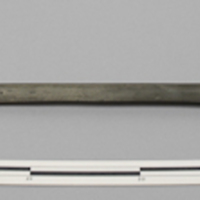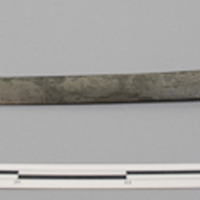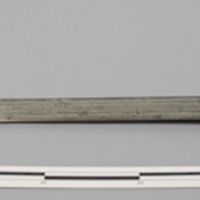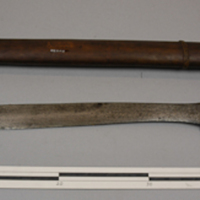Keris
Text
Kris [.1] with wavy blade, silver mounted hilt and wooden pommel. With wooden sheath [.2]. [El.B 2/3/2007]
Share this
Media
Images
Map Pitt Rivers Museum
Metadata
Subject
Dagger, sword
Date
Date made: 1911
Type
Weapon, Tool
Identifier
1911.1.51.1
Origin
Sulu Archipelago, Philippines
Materials
Silver, steel, copper alloy, wood, cane, incised
Processes: Carved, forged.
Processes: Carved, forged.
Physical Dimensions
Length: max 697 mm
Length: max 630 mm
Length: max 630 mm
Provenance
Edward Burnett Tylor. Collected by 1911.
Acquisition Date
1911
Short description
The large number of keris forms reflects the wide distribution of this weapon across Malaysia and Indonesia. There are seven major recognised areas of keris manufacturing: Java, Bali, Madura, Sumatra, the Malay Peninsula, Moro (Mindanao, Philippines) and Sajen. As far as can be deduced from bas relief depictions of warriors on the friezes of Buddhist temples, the keris had its origin on Java some time around the 14th century, spreading westwards and eastwards in following centuries (Egerton, 1896; Maisey 1998). The keris is a distinctive weapon, with an asymmetrical rapier-like blade adapted for stabbing, and a quite unique ‘pistol-grip’ hilt – significantly more ergonomic for the actual act of stabbing than almost all other rapier forms. We see such asymmetrical hilts in later European cavalry sabres, although this was a late development, and never popular. Keris were also used for rapid execution in certain Malay states, being thrust down diagonally behind the collarbone, through the lung and into the heart. Death was instantaneous. Perhaps the most distinctive characteristic of keris after the unique blade shape is that of pamor or pattern-welding. This is often mistakenly described as a form of damascening, although the two processes are completely different. Whereas damascening in the true Indo-Persian tradition is achieved through the slow cooling of the forged steel over days, encouraging the natural formation of crystalline structures of Martensite steel and Cementite iron, pamor is achieved through the artificial layering of wires or plates of pig iron and meteoric nickel steel, which are then folded and rippled into specific patterns. This technique is only known outside of the range of the keris in Japan, although the Japanese technique is considerably more limited than the Malay-Indonesian. Several different forms of pamor patterning are achievable, which can give the blade a wood-like grain, spots like leopardskin, and so on. The pamor was historically believed by Javanese people to impart certain mystical powers to the blade (Maryon, 1960; Frankel, 1963). Keris were traditionally understood to have great mystical power among the Malay people, and each was believed to be inhabited by a spirit. The nature of the keris’ spirit is reflected by its pamor, and by the blade shape or dapur. It was considered important for a prospective owner to acquire a keris whose spiritual persona was compatible with his own. Some keris were transmitted through family lineages as heirlooms. Keris Parts Terms: Blade (Wilah); Asymmetrical Blade Base (an additional welded fillet) (Ganja); Pistol-Gripped Hilt (Ukiran); Scabbard (Sampir or Warangka); Wide Scabbard-Mouth Piece (Batang). Research Conducted for DCF Cutting Edge 2006/2007 [AM].
Display status
Not on display
References
Recommended Reading: Annandale, N. & Robinson, H.C. (1903) Fasciculi Malayenses: Anthropology Part I. London: Longmans, Green & Co. Frankel, J.P. (1963) The Origin of Indonesian ‘Pamor’. In Technology & Culture, Vol.4, No.1, pp.14-21. LaRocca, D. (1996) The Gods of War: Sacred Imagery & the Decoration of Arms & Armour. New York: Metropolitan Museum of Art. Maisey (1998) Keris Website: www.nikhef.nl/~tonvr/keris/keris2/origin.html. Maryon, H. (1960) Pattern-Welding & Damascening of Sword-blades – Parts 1 & 2. Studies in Conservation, Vol.5, No.1. Shelford, R. (1901) A Provisional Classification of the Swords of the Sarawak Tribes. In Journal of the Royal Anthropoogical Institute, Vol. 31, pp.219-28.
Official Website
Collection
Cite this Page
“Keris,” Mapping Philippine Material Culture, accessed April 20, 2024, https://philippinestudies.uk/mapping/items/show/27692.
Subjects
Geolocation
Sensitive Content
Mapping Philippine Material Culture collates digital material from institutions, and some of this material is inherently colonial and contains words, terms and phrases that are inaccurate, derogatory and harmful towards Filipino and Filipino diasporic communities. Catalogue transcriptions, book titles, exhibition titles and museum titles may contain harmful terms. We recognise the potential for the material to cause physical and mental distress as well as evoke strong emotions. Owing to the scale of the collection’s data, a process to implement sensitive-content warnings in the displayed data is still incomplete. The material within the catalogue does not represent Mapping Philippine Material Culture’s views. Mapping Philippine Material Culture maintains a strong anti-colonial, anti-racist position and affirms its support for centring the humanity of historically marginalised and disenfranchised communities.
Facebook Twitter



